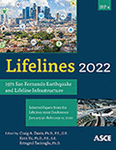Study on Self-Centering Seismic Isolation at the Bottom of Fixed Pier in Continuous Bridge
Publication: Lifelines 2022
ABSTRACT
In general, only one fixed pier is set in a continuous bridge. It is difficult to satisfy seismic demand of the fixed pier in a highly seismic area. To solve this problem, a pier-bottom seismic isolation structure with self-centering (PSIS-S) was placed at the bottom of the fixed pier, whose contact surface was elliptical. Under a strong earthquake, there was a relative swing between the bottom of the fixed pier and bearing platform, preventing the seismic energy from transferring to the fixed pier and superstructure. After the peak value of the ground motion, the continuous bridge can basically return to the initial equilibrium position under the action of the self-weight and seismic residual energy. A shake table test and simulations of a three-span continuous bridge were conducted. Then, taking a five-span continuous bridge as an example, the influence of main parameters of the PSIS-S structure on its seismic isolation effect, was studied. The results showed that the PSIS-S structure can effectively reduce the seismic response of the fixed pier, and that the residual deformation of the bridge was small, meaning that the PSIS-S structure had a self-centering capability. The ratio of the long radius to the short radius of the ellipse had a great influence on the seismic isolation effect of the PSIS-S structure, but the effect of friction coefficient could be ignored.
Get full access to this article
View all available purchase options and get full access to this chapter.
REFERENCES
Chaudhary, M. T., Abé, M., and Fujino, Y. (2001). “Effect of structural details on seismic performance of base-isolated bridges.” Proc Int Modal Anal Conf IMAC, 2, 1351-1357.
Della Corte, G., De Risi, R., and Di Sarno, L. (2013). “Approximate Method for Transverse Response Analysis of Partially Isolated Bridges.” J Bridge Eng, 18(11), 1121-1130.
Gjorgjiev, I., and Garevski, M. (2013). “A polynomial analytical model of rubber bearings based on series of tests.” Eng. Struct., 56, 600-609.
Hedayati Dezfuli, F., and Alam, M. S. (2013). “Multi-criteria optimization and seismic performance assessment of carbon FRP-based elastomeric isolator.” Eng. Struct., 49, 525-540.
Hedayati Dezfuli, F., and Alam, M. (2014). “Performance-based assessment and design of FRP-based high damping.” Eng. Struct., 61, 166-183.
Hedayati Dezfuli, F., Li, S., Alam, M. S., and Wang, J.-Q. (2017). “Effect of constitutive models on the seismic response of an SMA-LRB isolated highway bridge.” Eng. Struct., 148, 113-125.
Hedayati Dezfuli, F., and Alam, M. S. (2018). “Smart Lead Rubber Bearings Equipped with Ferrous Shape Memory Alloy Wires for Seismically Isolating Highway Bridges.” J. Earthqu. Eng., 22(6), 1042-1067.
Jónsson, M. H., Bessason, B., and Haflidason, E. (2010). “Earthquake response of a base-isolated bridge subjected to strong near-fault ground motion.” Soil Dyn. Earthqu. Eng., 30(6), 447-455.
Kataria, N. P., and Jangid, R. S. (2016). “Seismic protection of the horizontally curved bridge with semi-active variable stiffness damper and isolation system.” Adv. Struct. Eng., 2016, 19(7), 1103-1117.
Li, J., Xiang, N., Tang, H., and Guan, Z. (2016). “Shake-table tests and numerical simulation of an innovative isolation system for highway bridges.” Soil Dyn. Earthqu. Eng., 86, 55-70.
Loli, M., Knappett, J. A., Brown, M. J., Anastasopoulos, I., and Gazetas, G. (2019). “Centrifuge modeling of rocking-isolated inelastic RC bridge piers.” Earthqua. Eng. Struct. Dyn., 43(15), 2341-2359.
MOT (Ministry of Transport of the People’s Republic of China). (2020). Guidelines for Seismic Performance Evaluation of Highway Bridges, JTG/T 2231-02-2021. Beijing.
Nacamuli, M. (2012). “Seismic protection of data centers using Ball-N-cone base isolation.” Struct. Congr. - Proc. Struct. Congr. 2012, 1373-1384.
Osgooei, P. M., Tait, M. J., and Konstantinidis, D. (2014). “Finite element analysis of unbonded square fiber-reinforced elastomeric isolators(FREIs) under lateral loading in different directions.” Compos. Struct., 113(1), 164-173.
Rahman Bhuiyan, A., and Alam, M. S. (2013). “Seismic performance assessment of highway bridges equipped with superelastic shape memory alloy-based laminated rubber isolation bearing.” Eng. Struct., 49, 396-407.
Russo, G., and Pauletta, M. (2013). “Sliding instability of fiber-reinforced elastomeric isolators in unbonded applications.” Eng. Struct., 48, 70-80.
Toopchi-Nezhad, H., Tait, M. J., and Drysdale, R. G. (2011). “Drysdale. Bonded versus unbonded strip fiber reinforced elastomeric isolators:Finite element analysis.” Compos. Struct., 93(2), 850-859.
Wang, J.-W., Zhang, W.-G., and Li, J.-Z. (2014). “Displacement-based aseismic design method for rocking bridge piers with posttensioned tendons.” J Vib Shock, 33(24), 106-111(in Chinese).
Xia, X., and Chen, X.-C. (2013). “Restrainer Effect on Rocking Response of Tall Pier with Pile Foundations.” Tongji Daxue Xuebao, 41(10), 1470-1475.
Xia, X., and Chen, X.-C. (2013). “Study on Analytical Model for Rocking Isolation of Tall Piers with Pile Foundations.” Tiedao Xuebao, 35(11), 86-91.
Information & Authors
Information
Published In
History
Published online: Nov 16, 2022
Authors
Metrics & Citations
Metrics
Citations
Download citation
If you have the appropriate software installed, you can download article citation data to the citation manager of your choice. Simply select your manager software from the list below and click Download.
